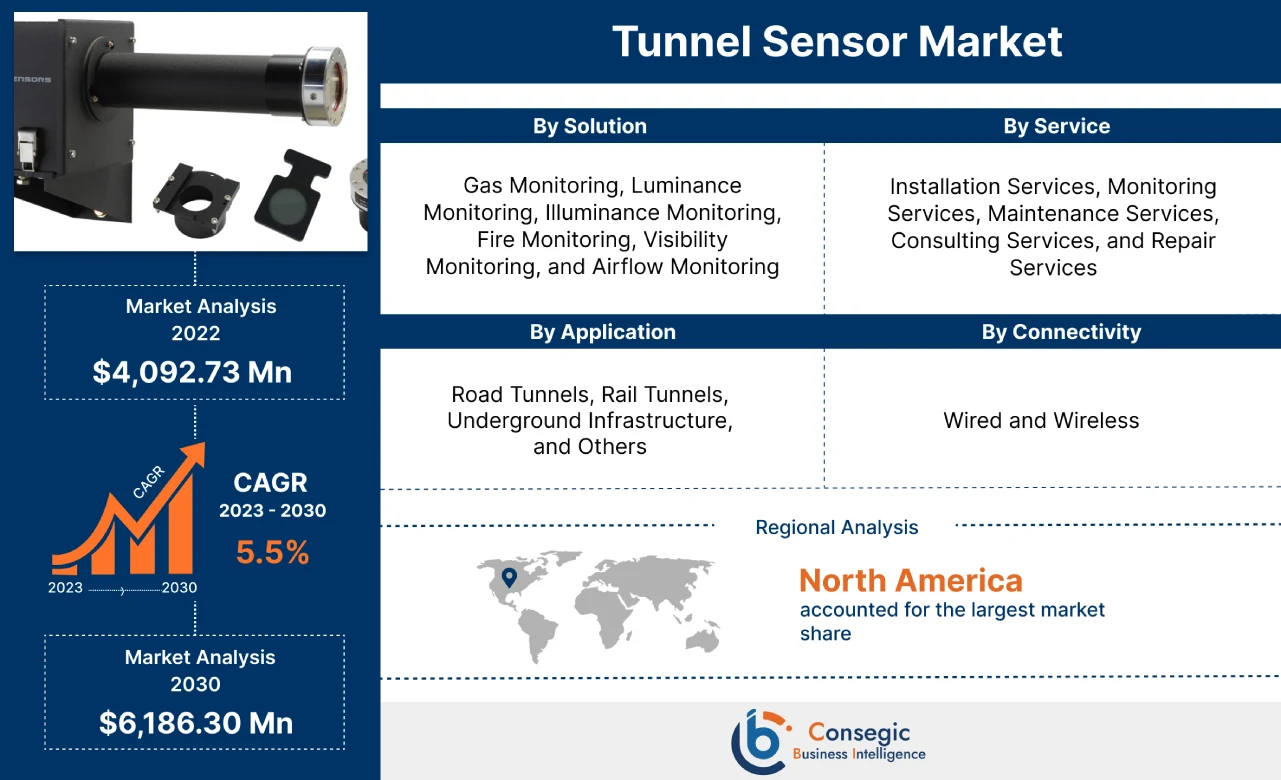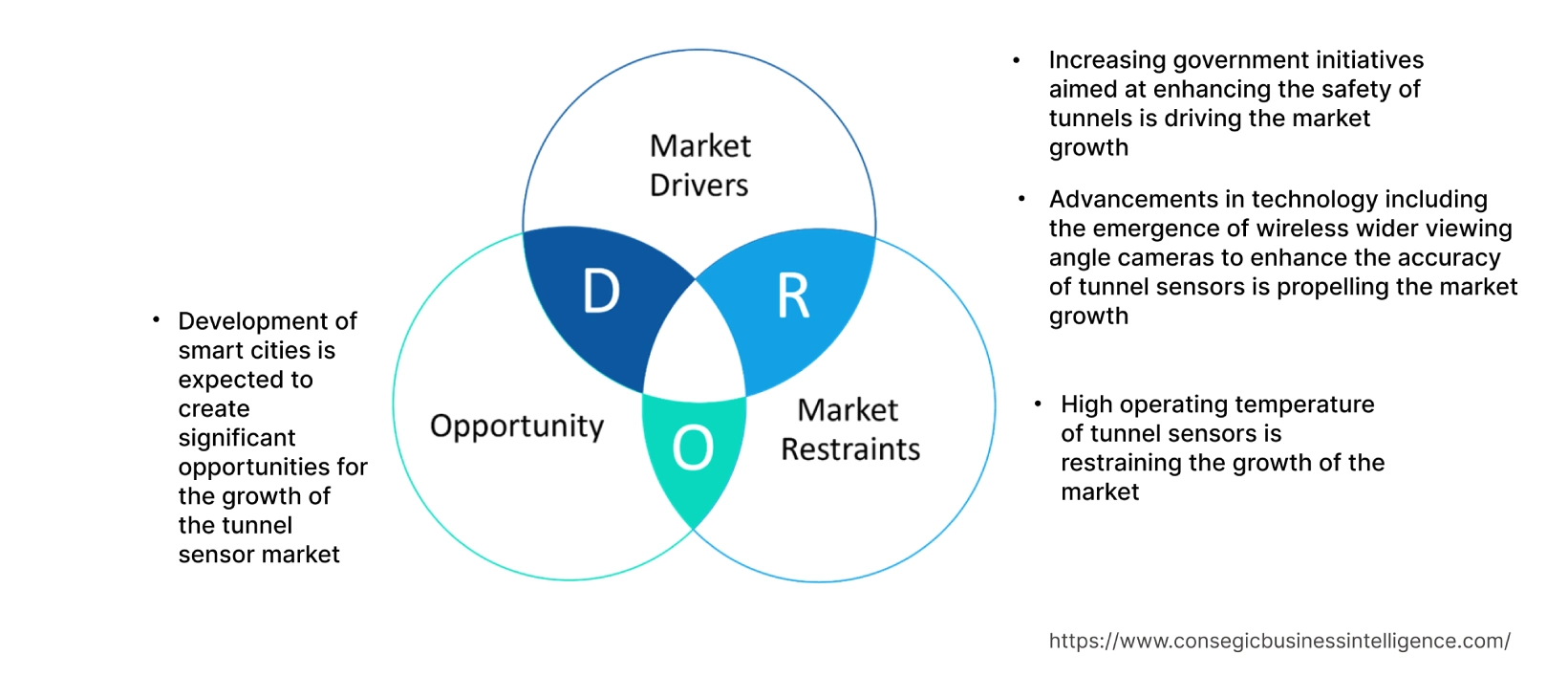Tunnel Sensor Market Size :
Global Tunnel Sensor Market size is estimated to reach over USD 6,186.30 Million by 2030 from a value of USD 4,092.73 Million in 2022, growing at a CAGR of 5.5% from 2023 to 2030.
Tunnel Sensor Market Scope & Overview:
A tunnel sensor is a specialized device designed to monitor and measure various environmental conditions within tunnels including road and rail tunnels. The sensors capture data related to parameters namely air quality (including levels of pollutants and gases), temperature, humidity, visibility, and even structural stability. The collected data is crucial for maintaining safe and efficient tunnel operations, enabling timely responses to potential hazards, and ensuring optimal conditions for both the infrastructure and the individuals utilizing the tunnel.
Tunnel Sensor Market Insights :
Tunnel Sensor Market Dynamics - (DRO) :
Key Drivers :
Increasing government initiatives aimed at enhancing the safety of tunnels
Governments and regulatory bodies are establishing strict safety standards for tunnel operations. The standards frequently require the installation of advanced sensor systems to monitor various aspects including air quality, temperature, humidity, visibility, and structural integrity. The sensors help operators comply with the standards by providing accurate and real-time data that facilitates adherence to safety regulations. Additionally, governments recognize that tunnels are vulnerable to various risks, including fires, accidents, and hazardous material leaks. Furthermore, by mandating the deployment of the sensors, authorities identify potential risks early, allowing for timely responses and mitigating the impact of emergencies. Analysis of market trends concludes that the implementation of stringent government regulations to improve the safety of tunnels is contributing significantly in accelerating the growth of the tunnel sensor market. For instance, in March 2021, the government of the United Kingdom passed the road tunnel safety amendment to make improvements in road tunnel safety. The enhancements mandate the installation of the sensors, thereby promoting the tunnel sensor market demand.
Advancements in technology including the emergence of wireless wider viewing angle cameras to enhance the senor accuracy
Modern sensor technologies offer higher levels of accuracy and precision in data measurement. Enhanced accuracy ensures that the collected data is reliable and utilized for making informed decisions about tunnel safety and management. Additionally, sensors with multiple sensing capabilities monitor various parameters simultaneously namely air quality, temperature, humidity, and visibility. Moreover, wireless communication capabilities allow sensors to transmit data remotely to a central monitoring system. Real-time data transmission enhances the speed of response to changing conditions, enabling swift reactions to potential hazards and emergencies. Analysis of market trends concludes that the advent of wider viewing angle cameras to provide better monitoring of the tunnels is also contributing in promoting the tunnel sensor market demand. For instance, in October 2022, ACOEM Group launched LUMIOS-IT, an advanced tunnel sensor to provide precise and consistent luminance measurements within the tunnel bore. In addition, the monitor's viewing angle is present at 20° and the sensor is contained within a waterproof, powder-coated stainless steel box to offer enhanced longevity.
Key Restraints :
High operating temperature of the sensors
High temperatures accelerate the degradation of sensor components and materials over time leading to reduced sensor accuracy, performance, and lifespan. Additionally, sensors that are not designed to withstand elevated temperatures experience repeated failures, requiring more frequent replacements and maintenance, resulting in increased operational costs for tunnel operators. Moreover, sensors operating in high-temperature environments require complex calibration procedures to maintain accuracy. Calibrating sensors accurately under such conditions is challenging and time-consuming, further impeding the growth of the global tunnel sensor market.
Future Opportunities :
Development of smart cities is expected to create significant opportunities
Smart cities aim to create seamless and integrated transportation systems that promote efficient mobility. The sensors provide essential data for managing traffic flow, reducing congestion, and optimizing travel times within tunnels. Real-time data from the sensors enable adaptive traffic management strategies that enhance transportation efficiency. Additionally, they provide continuous monitoring of environmental conditions including air quality, visibility, and temperature. The data enables immediate response to potential hazards, enhancing the safety of tunnel users and minimizing risks. Furthermore, smart cities focus on sustainability and reducing environmental impacts. The sensors monitor air quality and pollutant levels within tunnels, enabling authorities to take proactive measures to control emissions and improve urban air quality. Analysis of market trends concludes that the development of smart cities is emerging as one of many tunnel sensor market opportunities that will drive market expansion.
Tunnel Sensor Market Report Insights :
| Report Attributes | Report Details |
| Study Timeline | 2017-2030 |
| Market Size in 2030 | USD 6,186.30 Million |
| CAGR (2023-2030) | 5.5% |
| By Solution | Gas Monitoring, Luminance Monitoring, Illuminance Monitoring, Fire Monitoring, Visibility Monitoring, and Airflow Monitoring |
| By Service | Installation Services, Monitoring Services, Maintenance Services, Consulting Services, and Repair Services |
| By Connectivity | Wired and Wireless |
| By Application | Road Tunnels, Rail Tunnels, Underground Infrastructure, and Others |
| By Region | North America, Europe, Asia-Pacific, Latin America, and Middle East & Africa |
| Key Players | Bristol Industrial & Research Associates Ltd, SICK AG, Altech Corporation, Acoem, Tunnel Sensors Ltd., Advance Technologies Asia, CODEL International LTD, GEONICA, DURAG GROUP, Safibra, s.r.o. |
| Geographies Covered | |
| North America | U.S. Canada Mexico |
| Europe | U.K. Germany France Spain Italy Russia Benelux Rest of Europe |
| APAC | China South Korea Japan India Australia ASEAN Rest of Asia-Pacific |
| Middle East and Africa | GCC Turkey South Africa Rest of MEA |
| LATAM | Brazil Argentina Chile Rest of LATAM |
| Report Coverage | Revenue Forecast, Competitive Landscape, Growth Factors, Restraint or Challenges, Opportunities, Environment & Regulatory Landscape, PESTLE Analysis, PORTER Analysis, Key Technology Landscape, Value Chain Analysis, Cost Analysis, and Regional Trends & Forecast |
Tunnel Sensor Market Segmental Analysis :
By Solution :
The solution segment is classified into gas monitoring, luminance monitoring, illuminance monitoring, fire monitoring, visibility monitoring, and airflow monitoring. In 2022, the Visibility monitoring segment accounted for the highest tunnel sensor market share as visibility is a paramount concern in tunnel safety. Poor visibility conditions, due to fog, smoke, and dust leads to accidents, collisions, and hazards for drivers and pedestrians. Additionally, ensuring clear visibility inside tunnels is crucial for reducing the risk of accidents and improving emergency response. Visibility monitoring sensors provide real-time data on visibility conditions, enabling operators to take action in case of reduced visibility due to smoke, fog, or other factors. For instance, SICK AG launched VICOTEC450 sensor for visibility monitoring in tunnels. The advanced sensor draws air from inside the tunnel and determines the visibility with a high level of accuracy using scattered light technology, hence contributing notably in boosting the proliferation of visibility monitoring segment.
Gas monitoring segment is expected to witness the fastest CAGR in the tunnel sensor market in the upcoming years. Analysis of tunnel sensor market trends concludes that the growth is attributed to the increasing focus on air quality standards and pollution control by governments and environmental regulatory bodies. Tunnels accumulate pollutants from vehicle emissions, posing health risks to tunnel users and contributing to urban air pollution. Gas monitoring sensors enable compliance with air quality regulations by providing real-time data on pollutant levels. The real-time data enables operators to take immediate actions in response to sudden spikes in pollutant levels or the presence of hazardous gases, minimizing exposure and risks to users. Furthermore, many regions are actively working toward reducing greenhouse gas emissions and pollution from vehicles. Gas monitoring sensors play a crucial role in assessing emission levels within tunnels, contributing to emission reduction strategies, and encouraging cleaner transportation options. Examination of market trends concludes that the ability of gas monitoring sensors to provide real-time data on pollutant levels is predicted to drive tunnel sensor market growth during the forecast period.
By Service :
The service segment is categorized into installation services, monitoring services, maintenance services, consulting services, and repair services. In 2022, the Monitoring services segment accounted for the highest tunnel sensor market share as monitoring services offer a cost-effective alternative to sensor monitoring systems. Additionally, monitoring services include ongoing maintenance as service providers manage sensor calibration, troubleshooting, and repairs, reducing the burden on tunnel operators and ensuring consistent sensor performance. Moreover, monitoring services offer real-time data analysis and alerts, ensuring timely responses to changing conditions. Immediate notifications enable proactive interventions in the case of emergencies and abnormal sensor readings, thus contributing remarkably in fueling the proliferation of monitoring services segment.
Maintenance services are anticipated to register the fastest CAGR as preventive maintenance is essential for avoiding unexpected breakdowns and costly downtime. Maintenance services provide regular inspections, diagnostics, and adjustments to identify and address potential issues before leading to major failures. In addition, regular maintenance extends the lifespan of equipment, reducing the demands for frequent replacements from the equipment, thus encouraging businesses to invest in maintenance services to maximize the longevity of the assets. Moreover, maintenance services optimize the performance of equipment by fine-tuning settings and calibrating sensors, ensuring that systems operate at peak efficiency, saving energy, and improving productivity. Examination of market trends concludes the above-mentioned factors are contributing remarkably in spurring the expansion of the maintenance services segment during the forecast period.
By Connectivity :
The connectivity segment is bifurcated into wired and wireless. Wireless segment accounted for the largest market share in 2022 and are also predicted to witness the fastest CAGR during the forecast period. Wireless sensors eliminate the user demand for extensive wiring, conduits, and cable management, simplifying the installation process, reducing installation time, and minimizing disruptions to tunnel operations. Additionally, wireless sensors are easily repositioned or relocated, offering improved flexibility and enabling tunnel operators to adapt to changing conditions, expand sensor networks, and optimize data collection strategies. Examination of market trends concludes that the improved flexibility offered by wireless sensors is contributing remarkably in fueling the tunnel sensor market growth.
By Application :
The application segment is divided into road tunnels, rail tunnels, underground infrastructure, and others. Road tunnels accounted for the largest market share of 45.5% in 2022 as the sensors play a vital role in road tunnels by providing real-time data and insights that contribute to safety, traffic management, and tunnel operations. Sensors measure air quality parameters including carbon monoxide (CO), nitrogen dioxide (NO2), particulate matter (PM), and volatile organic compounds (VOCs). The data helps assess and maintain healthy air quality levels within the tunnel, minimizing health risks to drivers and passengers. Additionally, the sensors monitor visibility conditions within the tunnel, crucial for maintaining safe driving conditions, especially in scenarios involving fog, smoke, and other visibility-reducing factors. Subsequently, the aforementioned factors are collectively responsible in bolstering the proliferation of the road tunnels segment.
Rail tunnels are expected to register the fastest CAGR in the tunnel sensor market during the forecast period. The growth is attributed to the ability of the sensors to identify the presence of smoke or flames within the tunnel. Early detection of fires enables prompt responses including activating fire suppression systems, alerting emergency responders, and initiating evacuation procedures. In addition, the sensors detect incidents namely collisions, derailments, and obstructions on the tracks. The information triggers immediate response measures, including alerting rail operators, and emergency services, and coordinating rescue operations. Analysis of tunnel sensor market trends concludes that the increasing government initiatives in enhancing rail safety are also contributing significantly in boosting the market growth. For instance, April 2021, Network Rail of the United Kingdom funded approximately USD 595,065 and signed a contract with COWI to improve the accuracy, efficiency and safety of tunnels, resulting in a safer railway operation. Subsequently, the above-mentioned factors are collectively responsible in driving the expansion of rail tunnels segment.
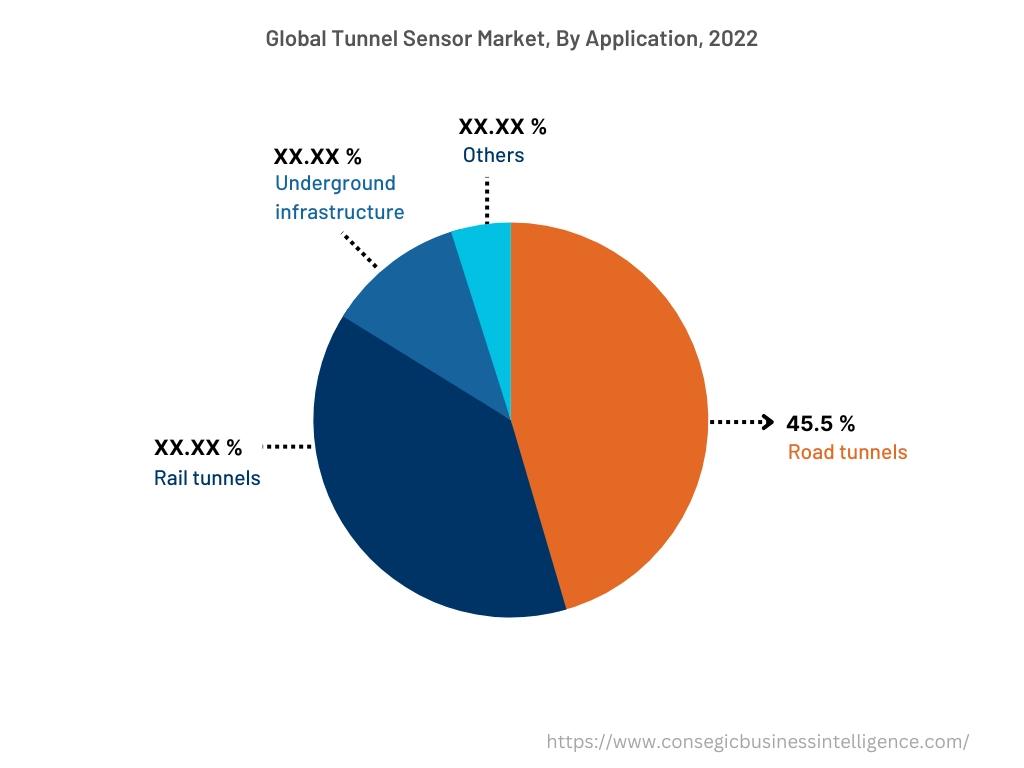
By Region :
The regional segment includes North America, Europe, Asia Pacific, Middle East and Africa, and Latin America.
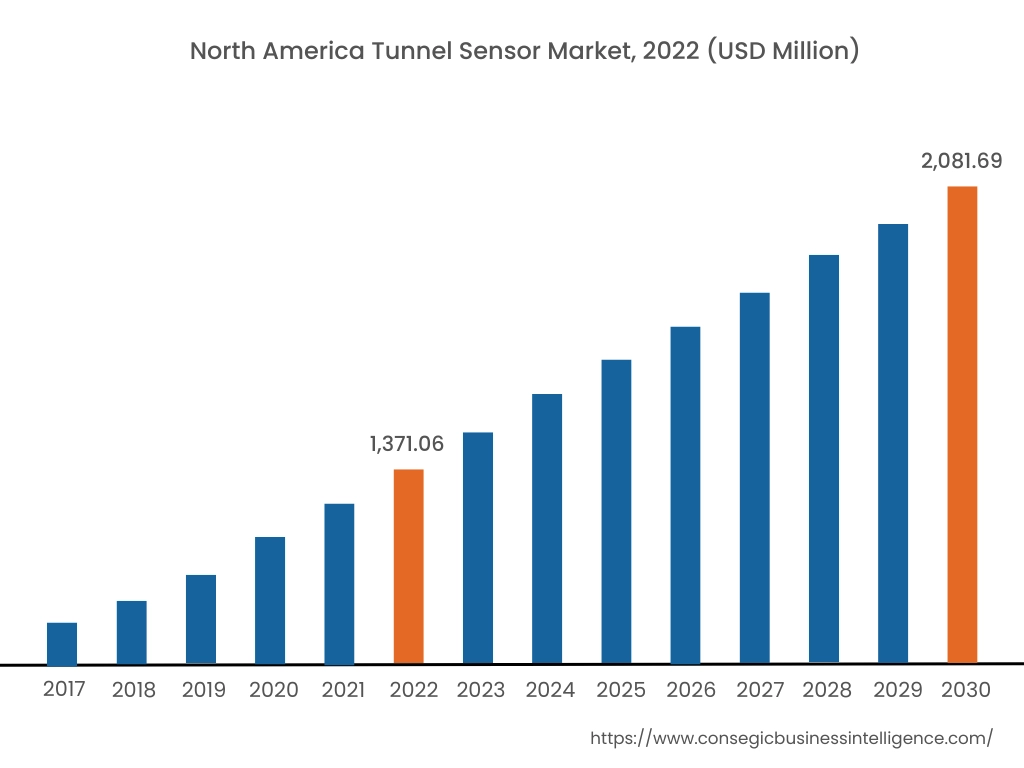
North America accounted for the largest market share of USD 1,371.06 million in 2022 and is expected to reach USD 2,081.69 million in 2030 in the tunnel sensor market. In addition, in the region, the U.S. accounted for the maximum revenue share of 61.4% in the year 2022. North America places a strong emphasis on safety regulations and standards. Regulatory bodies enforce strict guidelines for tunnel safety and air quality, driving the adoption of the sensors to ensure compliance and the well-being of tunnel users. Additionally, governments and companies in the private industry in North America are investing heavily in infrastructure development and modernization including the implementation of advanced sensor systems to enhance the safety and efficiency of tunnel operations. For instance, in April 2023, the governments of Canada and Saskatchewan invested USD 42.1 million to support 21 infrastructure projects across the province. The tunnel sensor market analysis concluded that the implementation of stringent government regulations and increasing government investments are the major factors responsible for driving the growth of the market in the region.
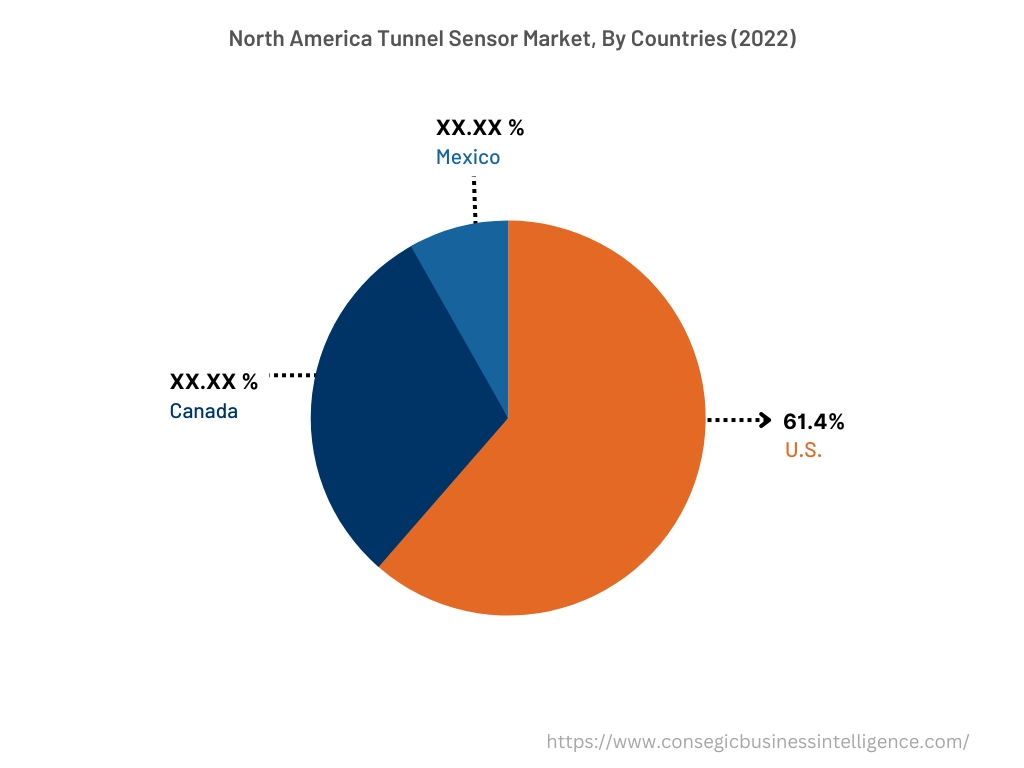
Asia Pacific is predicted to witness the fastest CAGR of 5.8% in the tunnel sensor market in the upcoming years. The tunnel sensor market analysis concluded that the growth is attributed to the presence of two densely populated countries including India and China that creates heavy traffic congestion. Tunnels are vital for efficient urban transportation, creating a strong demand for monitoring solutions to optimize traffic flow and ensure safety. Additionally, many Asia Pacific countries are becoming smart and connected, leveraging the Internet of Things (IoT) for improved urban management. The sensors are integral components of the initiatives, contributing to data-driven decision-making. Moreover, air quality and environmental concerns are also driving the adoption of sensors to monitor pollutant levels and emissions within tunnels. Asia Pacific countries' focus on sustainability aligns with the use of sensors to mitigate the impact of tunnel operations on the environment. Furthermore, the region has a diverse range of transportation modes including roadways, railways, and transit systems that require specialized sensor solutions to ensure safe and efficient tunnel operations.
Top Key Players & Market Share Insights:
The landscape of the tunnel sensor market is highly competitive and has been examined in the report, along with complete profiles of the major companies operating in tunnel sensor industry. In addition, the surge in innovations, acquisitions, mergers, and partnerships has further accelerated the proliferation of the market. Major players in the market include-
- Bristol Industrial & Research Associates Ltd
- SICK AG
- CODEL International LTD
- GEONICA
- DURAG GROUP
- Altech Corporation
- Acoem
- Tunnel Sensors Ltd.
- Advance Technologies Asia
- Safibra, s.r.o.
Recent Industry Developments :
- In September 2022, Worldsensing launched novel tunnel monitoring solution that aims to improve safety in tunneling process. Its solution has sensors pre-embedded into concrete segments which are used for lining tunnels, thereby avoiding expensive delays taking place during equipment installation.
- In October 2022, Tunnel Sensors Ltd launched LUMIOS-IT, a LUMIOS tunnel photometer that gives precise luminance measurements inside the tunnel bore.
Key Questions Answered in the Report
What is a tunnel sensor? +
A tunnel sensor is a specialized device designed to monitor and measure various environmental conditions within tunnels including road and rail tunnels. The sensors capture data related to parameters namely air quality (including levels of pollutants and gases), temperature, humidity, visibility, and even structural stability.
What specific segmentation details are covered in the tunnel sensor market report, and how is the dominating segment impacting the market growth? +
Visibility monitoring tunnel sensors dominates the market in 2022 as visibility is a paramount concern in tunnel safety. Poor visibility conditions, due to fog, smoke, and dust lead to accidents, collisions, and hazards for drivers and pedestrians.
What specific segmentation details are covered in the tunnel sensor market report, and how is the fastest segment anticipated to impact the market growth? +
Maintenance services are anticipated to be the fastest-growing segment as preventive maintenance is essential for avoiding unexpected breakdowns and costly downtime. Maintenance services provide regular inspections, diagnostics, and adjustments to identify and address potential issues before leading to major failures.
Which region is anticipated to witness the highest CAGR during the forecast period, 2023-2030? +
Asia Pacific is anticipated to witness the fastest CAGR of 5.8% during the forecast period due to the development of smart cities that raise the demand for tunnel sensors to improve the safety of passengers.
